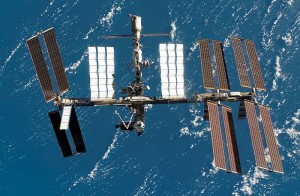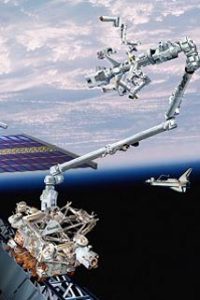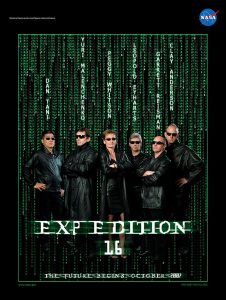Expedition 13 Arrives on Soyuz TMA-8
Life on the International Space Station
The Expedition 13 Crew shows off some moments from their stay on the International Space Station.
Soyuz TMA-8 launched on March 29, 2006 with Expedition 13 commander Pavel Vinogradov, Flight Engineer Jeff Williams, and Brazilian astronaut Marcos Pontes on board. Pontes was flying to the International Space Station as part of an arrangement between NASA and Brazil to carry out a series of experiments called “Centenario”. Brazil should have produced an experiment rack to be mounted on the exterior of the International Space Station as part of the arrangement, but this fell through for budgetary reasons.
Despite the supposedly unlucky number, the Expedition 13 crew was optimistic about the success of their mission and hoped for the return of the Space Shuttle, which would also bring a third Expedition 13 member, ESA’s Thomas Reiter from Germany. The Soyuz docked on March 31 and the combined crews started the usual handover duties while Pontes got going on his eight experiments. Pontes returned home with the Expedition 12 crew on April 8, 2006.
The first full week got off to a good start as Russian President Vladimir Putin called on April 12 to mark the 45th anniversary of the very first manned space flight, made by Russian Cosmonaut Yuri Gagarin. It was also the 25th anniversary of the first Space Shuttle Flight. Vinogradov jokingly invited Putin to visit them on the Space Station sometime.
Then, they got down to the more serious routine of maintenance that included loading rubbish in Progress M-55 and preparing for the arrival of Progress M-56. Vinogradov practiced with the TORU remote piloting system and Russian controllers transferred most of the remaining propellant from the Progress to the International Space Station tanks. They also canceled a planned boost of the station’s orbit and started troubleshooting when they discovered that a sunshade on Zvezda’s thrusters had failed to completely open.
In due course, Progress M-56 brought up new supplies and replaced M-55, which remained long enough for the crew to finish filling it up with trash and then burned up in Earth’s atmosphere. Vinogradov took care of some maintenance on the Elektron oxygen generator and the ventilation system and also tested the integrity of Zvezda’s pressure hull. Williams replaced a Remote Power Control Module in Destiny, a complicated operation that involved dismantling the crew quarters, and also took samples of the drinking water and replaced coolant water in the American EMUs. The Expedition crew also took care of software upgrades on the station laptops and unpacked cargo from the new Progress.
Experiments included work with a small American satellite called the Synchronized Position Hold, Engage, Reorient Experiment Satellite (SPHERES), which would become part of a group of three satellites programmed to perform maneuvers in formation. The other two would be brought up on STS-121 and the three would perform test maneuvers that included avoiding obstacles and station-keeping. It was hoped that technology based on the SPHERES would evolve into robotic assistants for astronauts. Williams reactivated the InSPACE experiment designed to study fluids that react to magnetic fields. They also observed an erupting volcano in the Aleutian Islands of Alaska.
During the last week of May, the crew began preparations for an EVA planned for June 1.
Stage EVA #1
The first spacewalk of Expedition 13 began at 18:48 June 1 with Williams and Vinogradov emerged from the Pirs airlock wearing Orlan suits. They got a spectacular view of southern Asia and the Pacific Ocean. Vinogradov took a moment to admire the view, “It’s like a fairy tale.” He repaired the the external component of the Elektron oxygen generator by replacing a clogged nozzle on a valve used to vent hydrogen. As a result, the Elektron could route hydrogen through its own path instead of through the same line used by a contamination-monitoring line.
The crew moved on to Zvezda’s wake. At one point, Vinogradov noticed a foot restraint from the Strela crane drifting off into space. “That’s bad,” he commented. Controllers tracking it from the ground watched it move into a separate orbit. The errant restraint posed no threat to the International Space Station. The spacewalkers took pictures of an antenna designed to be used by the European ATV that was suspected of interfering with the sunshade that should have opened during Russia’s abortive attempt to boost the station’s orbit. They also replaced a faulty camera with a new one that could provide images of the Mobile Base System.
Williams retrieved the final Biorisk container with microbes that had been exposed to the space environment. Vinogradov retrieved a metal plate for the Kromka study, which monitored the effects of thruster firings on the space station infrastructure. He also took pictures of an antenna that could have been interfering with the operation of a thruster and installed a new antenna in a nearby location.
With their tasks completed, they returned to the Pirs airlock. The 65th EVA devoted to the space station and last EVA by a two-man “caretaker” crew ended with a duration of 6 hours and 31 minutes.
Expedition 13 Continues
With the EVA complete, the crew worked on maintaining the suits and prepared for the arrival of Progress M-57 and STS-121. They made a practice run with cameras they would use to photograph the Discovery’s R-bar pitch maneuver when it arrived. Williams put Canadarm2 through a rehearsal of the maneuvers he would make to remove the MPLM from Discovery’s payload bay and dock it to Unity. Vinogradov replaced panels and smoke detectors and also practiced with the TORU remote control system he would use if something went wrong with the Progress’s automatic docking mechanisms. The Elektron unit failed again and attempts to reboot it didn’t last. Troubleshooters on the ground determined that its power unit needed replacing.
Progress M-57 docked on June 26, 2006, delivering 2,578 kilograms of cargo. By this point, the crew was focused on the final preparations of the STS-121 mission and would do most of the unloading after the Discovery’s Return to Flight mission.

A Three-Man Expedition Crew
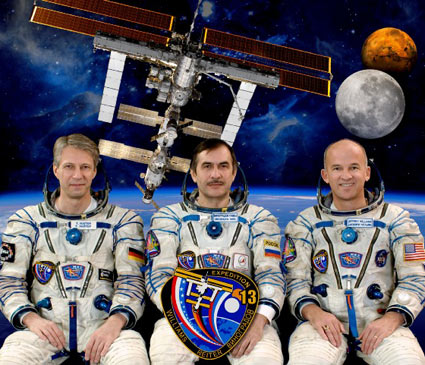
With Discovery on its way home, Williams depressurized PMA-2. Thomas Reiter had stayed behind when Discovery departed and he jumped right into the routine of maintenance and experiments. He and Williams installed an ESA experiment rack in Destiny and activated the Minus Eighty-degree Laboratory Freezer for ISS (MELFI), which would used to store experimental biology samples. While Vinogradov continued to wrestle with Elecktron, the crew also checked the oxygen generator that Discovery had delivered. Williams and Reiters also began preparations for a Stage EVA scheduled for early August.
On Earth, the European Space Agency’s leadership expressed interest in a transportation system similar to ones being developed by the Americans and the Russians, but acknowledged that they would probably have to form a partnership with one of the two for that to happen. A partnership with the Russians was the more likely of the two options though budgetary restraints lead to the cancellation of the Kliper spacecraft.
With the Space Shuttle program tentatively scheduled to end in 2010, NASA was in talks with potential contractors to develop an automated vessel. SpaceX had an unmanned option in the works that eventually became the Dragon capsule. Rocketplane Kistler was also in the running, and there was hope that one of the two could also produce a spacecraft capable of delivering humans to the space station.
Stage EVA #2

On August 3, Pavel Vinogradov helped Jeff Williams and Thomas Reiter suit up for their EVA. The two spacewalkers exited through Quest at 10:04. They installed a Floating Potential Measurement Unit (FPMU) on the S-1 Truss segment and extended its sensor arms. The FPMU would measure the electric potential of the station in the hopes of minimizing the potential damage from electrical arcs. Returning to the airlock exterior, they installed two containers for the Materials on the International Space Station Experiment (MISSE 3), which would continue studies of the effects of exposure to the space environment to a variety of materials. This ongoing study was meant to help improve materials used on future spacecraft.
Returning to the S-1 Truss, Williams installed a controller for a Thermal Radiator Rotary Joint and a light designed to assist future EVA astronauts using the MBS. He also removed a faulty GPS antenna. Reiter replaced a computer on S-1 and inspected a radiator beam valve module destined to host a Spool Positioning Device. He took images using a new infrared camera designed to photograph the RCC thermal protection on the Space Shuttle. He also installed a vacuum system valve on the exterior of Destiny that would assist with future experiments. Both men installed starboard jumpers and Spool Positioning Devices (SPD) on the S-1 Truss.
They wrapped up the planned EVA activities earlier than planned and got started on some additional tasks to get a little ahead of the schedule. Williams moved two articulated foot restraints that would be used during the STS-115 mission and photographed a scratch on the exterior of Quest. Reiter moved on to PMA-1 to inspect and retrieve a ball stack used to stow equipment on the station exterior.
The EVA ended with a duration of 5 hours and 54 minutes. It had gone so well that fellow astronaut Steve Bowman, who had been acting as Spacewalk Intravehicular Officer from the Houston control center, kidded, “We will never let this happen again. Wait til you see next week’s schedule.”
Expedition 13 Continues

On August 4, Thomas Reiter set a new ESA duration record with 209 days, 12 hours and 25 minutes of total space flight. He had also served on the Russian Mir space station. The ESA hoped that his contributions to the European space effort was a foreshadowing of a more robust ESA program. By the time he was due to return to Earth, he would have a total of more than a year in space.
After the EVA, the Expedition crew began preparations for the arrival of the STS-115 flight. They packed up items due to return to Earth and performed routine maintenance that included testing the Carbon Dioxide Removal Assembly. Controllers on the ground moved Canadarm2 to Destiny so they could get a good look at markings on the outside of the International Space Station. These marking would help insure that the P-3/P-4 truss that the Atlantis would deliver was aligned correctly with the rest of the station. Once that was complete, Williams moved Canadarm2 to a position near the Mobile Transporter where it could get some good views of the exposed end of the P-1 Truss structure. The engines on Progress M-56 were used to boost the station’s orbit.
When the launch of STS-115 was delayed until September 9, the crew used the extra time to complete preparations and also take care of a few experiments. Williams took part in a study of the interactions of cosmic rays with the human body that involved wearing a helmet with sensors that would monitor brain activity and visual perceptions for an entire orbit.
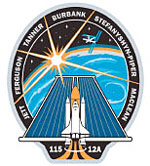
FC Barcelona Soccer Team Chats with Expedition 13
While traveling for a game, a soccer team from Barcelona, Spain, finds the time to visit Houston Mission Control and chat with the Expedition 13 crew.
Soyuz Undocking
The Expedition 13 crew returns home on September 28, 2006.
International Space Station Collectibles on eBay
[simple-rss feed=”http://rest.ebay.com/epn/v1/find/item.rss?keyword=International+Space+Station&categoryId1=1&sortOrder=BestMatch&programid=1&campaignid=5337337555&toolid=10039&listingType1=All&lgeo=1&topRatedSeller=true&feedType=rss” limit=5]


